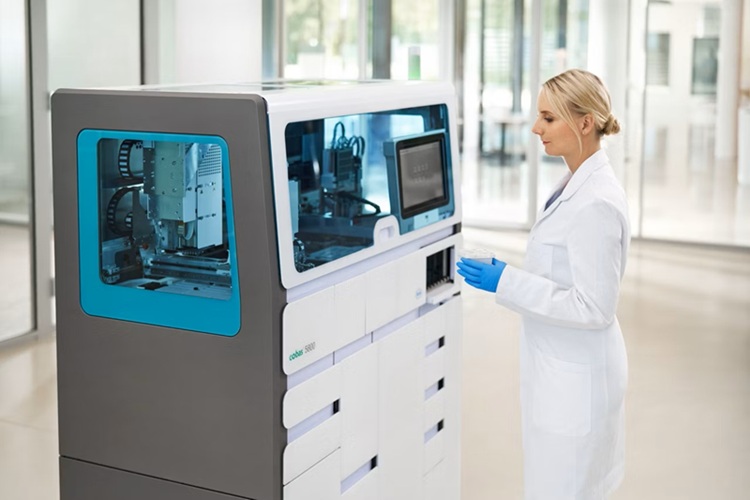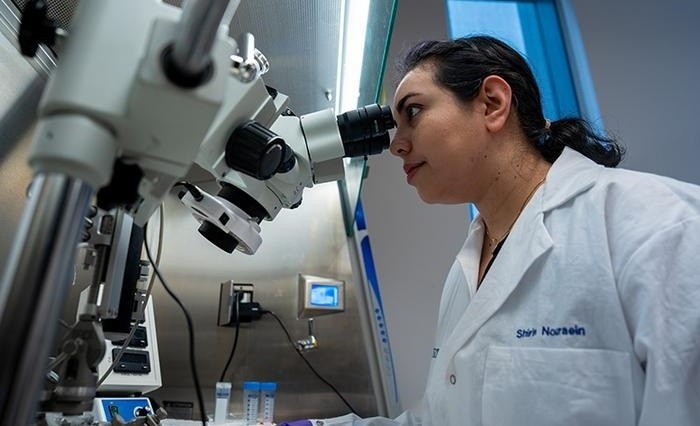Smartphone Device Created Performs Blood Tests
|
By LabMedica International staff writers Posted on 03 Apr 2014 |

Image: Schematics of the Qloudlab smartphone device (Photo courtesy of Alain Herzog).
A smartphone device has been created that can perform blood tests—an innovation that could improve the quality of life for people undergoing treatment for the prevention of blood clots.
The formation of blood clots in the arteries and veins can increase the risk of heart attack and stroke, and individuals at high risk of blood clots are often treated with anticoagulants drugs that thin the blood and prevent the clotting process.
Bioengineers at the École Polytechnique Fédérale de Lausanne (EPFL; Switzerland) microengineering laboratory have created a device that could allow patients undergoing anticoagulant therapy to self-monitor. The gadget consists of a small single-use film that is attached to the screen of a smartphone. The film is made of a microstructured plastic layer that is a few micrometers thick.
When blood enters the film through capillary action, the device can detect a molecule present in blood that initiates coagulation, the process by which blood forms clots. The phone is then able to interpret the results by analyzing interferences in the electric field on the surface of the smartphone's screen. This is a process similar to what happens when a finger comes into contact with the screen of a smartphone. The results are then sent to a specific smartphone application, created by Qloudlab (Lausanne, Switzerland), the start-up company based at EPFL. This data can then be sent directly to a physician, who can assess whether a patient’s treatment needs to be modified.
Qloudlab has recently applied for a patent for the device, and the creators have recently received funding from Venture Kick (St. Gallen, Switzerland) that has allowed them to recruit a biochemist. The team hopes that by the end of next year, they will have shown that the device is as reliable as a laboratory test and can progress toward commercialization. Arther Queval, MSc, the founder of Qloudlab, said, “Such a test will significantly improve the quality of life for people undergoing this kind of treatment."
Related Links:
École Polytechnique Fédérale de Lausanne
Qloudlab
Venture Kick
The formation of blood clots in the arteries and veins can increase the risk of heart attack and stroke, and individuals at high risk of blood clots are often treated with anticoagulants drugs that thin the blood and prevent the clotting process.
Bioengineers at the École Polytechnique Fédérale de Lausanne (EPFL; Switzerland) microengineering laboratory have created a device that could allow patients undergoing anticoagulant therapy to self-monitor. The gadget consists of a small single-use film that is attached to the screen of a smartphone. The film is made of a microstructured plastic layer that is a few micrometers thick.
When blood enters the film through capillary action, the device can detect a molecule present in blood that initiates coagulation, the process by which blood forms clots. The phone is then able to interpret the results by analyzing interferences in the electric field on the surface of the smartphone's screen. This is a process similar to what happens when a finger comes into contact with the screen of a smartphone. The results are then sent to a specific smartphone application, created by Qloudlab (Lausanne, Switzerland), the start-up company based at EPFL. This data can then be sent directly to a physician, who can assess whether a patient’s treatment needs to be modified.
Qloudlab has recently applied for a patent for the device, and the creators have recently received funding from Venture Kick (St. Gallen, Switzerland) that has allowed them to recruit a biochemist. The team hopes that by the end of next year, they will have shown that the device is as reliable as a laboratory test and can progress toward commercialization. Arther Queval, MSc, the founder of Qloudlab, said, “Such a test will significantly improve the quality of life for people undergoing this kind of treatment."
Related Links:
École Polytechnique Fédérale de Lausanne
Qloudlab
Venture Kick
Latest Hematology News
- Platelet Activity Blood Test in Middle Age Could Identify Early Alzheimer’s Risk
- Microvesicles Measurement Could Detect Vascular Injury in Sickle Cell Disease Patients
- ADLM’s New Coagulation Testing Guidance to Improve Care for Patients on Blood Thinners
- Viscoelastic Testing Could Improve Treatment of Maternal Hemorrhage
- Pioneering Model Measures Radiation Exposure in Blood for Precise Cancer Treatments
- Platelets Could Improve Early and Minimally Invasive Detection of Cancer
- Portable and Disposable Device Obtains Platelet-Rich Plasma Without Complex Equipment
- Disposable Cartridge-Based Test Delivers Rapid and Accurate CBC Results
- First Point-of-Care Heparin Monitoring Test Provides Results in Under 15 Minutes

- New Scoring System Predicts Risk of Developing Cancer from Common Blood Disorder
- Non-Invasive Prenatal Test for Fetal RhD Status Demonstrates 100% Accuracy
- WBC Count Could Predict Severity of COVID-19 Symptoms
- New Platelet Counting Technology to Help Labs Prevent Diagnosis Errors
- Streamlined Approach to Testing for Heparin-Induced Thrombocytopenia Improves Diagnostic Accuracy
- POC Hemostasis System Could Help Prevent Maternal Deaths
- New Test Assesses Oxygen Delivering Ability of Red Blood Cells by Measuring Their Shape
Channels
Clinical Chemistry
view channel
Chemical Imaging Probe Could Track and Treat Prostate Cancer
Prostate cancer remains a leading cause of illness and death among men, with many patients eventually developing resistance to standard hormone-blocking therapies. These drugs often lose effectiveness... Read more
Mismatch Between Two Common Kidney Function Tests Indicates Serious Health Problems
Creatinine has long been the standard for measuring kidney filtration, while cystatin C — a protein produced by all human cells — has been recommended as a complementary marker because it is influenced... Read moreMolecular Diagnostics
view channel
Four-Gene Blood Test Rules Out Bacterial Lung Infection
Lower respiratory tract infections (LRTIs) are among the most common reasons for antibiotic prescriptions, yet distinguishing bacterial infections from viral ones remains notoriously difficult.... Read more
New PCR Test Improves Diagnostic Accuracy of Bacterial Vaginosis and Candida Vaginitis
Bacterial vaginosis (BV) impacts approximately 25% of women of reproductive age, while up to 75% of women experience candida vaginitis (CV) at least once in their lifetime. Vaginal symptoms are one of... Read moreHematology
view channel
Platelet Activity Blood Test in Middle Age Could Identify Early Alzheimer’s Risk
Early detection of Alzheimer’s disease remains one of the biggest unmet needs in neurology, particularly because the biological changes underlying the disorder begin decades before memory symptoms appear.... Read more
Microvesicles Measurement Could Detect Vascular Injury in Sickle Cell Disease Patients
Assessing disease severity in sickle cell disease (SCD) remains challenging, especially when trying to predict hemolysis, vascular injury, and risk of complications such as vaso-occlusive crises.... Read more
ADLM’s New Coagulation Testing Guidance to Improve Care for Patients on Blood Thinners
Direct oral anticoagulants (DOACs) are one of the most common types of blood thinners. Patients take them to prevent a host of complications that could arise from blood clotting, including stroke, deep... Read moreImmunology
view channel
Gene Signature Test Predicts Response to Key Breast Cancer Treatment
DK4/6 inhibitors paired with hormone therapy have become a cornerstone treatment for advanced HR+/HER2– breast cancer, slowing tumor growth by blocking key proteins that drive cell division.... Read more
Chip Captures Cancer Cells from Blood to Help Select Right Breast Cancer Treatment
Ductal carcinoma in situ (DCIS) accounts for about a quarter of all breast cancer cases and generally carries a good prognosis. This non-invasive form of the disease may or may not become life-threatening.... Read moreMicrobiology
view channelRapid POC Tuberculosis Test Provides Results Within 15 Minutes
Tuberculosis remains one of the world’s deadliest infectious diseases, and reducing new cases depends on identifying individuals with latent infection before it progresses. Current diagnostic tools often... Read more
Rapid Assay Identifies Bloodstream Infection Pathogens Directly from Patient Samples
Bloodstream infections in sepsis progress quickly and demand rapid, precise diagnosis. Current blood-culture methods often take one to five days to identify the pathogen, leaving clinicians to treat blindly... Read morePathology
view channelAI Tool Outperforms Doctors in Spotting Blood Cell Abnormalities
Diagnosing blood disorders depends on recognizing subtle abnormalities in cell size, shape, and structure, yet this process is slow, subjective, and requires years of expert training. Even specialists... Read more
AI Tool Rapidly Analyzes Complex Cancer Images for Personalized Treatment
Complex digital biopsy images that typically take an expert pathologist up to 20 minutes to assess can now be analyzed in about one minute using a new artificial intelligence (AI) tool. The technology... Read moreIndustry
view channel
Abbott Acquires Cancer-Screening Company Exact Sciences
Abbott (Abbott Park, IL, USA) has entered into a definitive agreement to acquire Exact Sciences (Madison, WI, USA), enabling it to enter and lead in fast-growing cancer diagnostics segments.... Read more
























